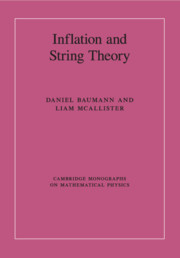Book contents
- Frontmatter
- Dedication
- Contents
- Preface
- Notation and conventions
- 1 Inflation: theory and observations
- 2 Inflation in effective field theory
- 3 Elements of string theory
- 4 What is string inflation?
- 5 Examples of string inflation
- 6 Conclusions and outlook
- Appendix A Mathematical preliminaries
- Appendix B The effective theory of inflation
- Appendix C Primordial perturbations from inflation
- References
- Index
4 - What is string inflation?
Published online by Cambridge University Press: 05 May 2015
- Frontmatter
- Dedication
- Contents
- Preface
- Notation and conventions
- 1 Inflation: theory and observations
- 2 Inflation in effective field theory
- 3 Elements of string theory
- 4 What is string inflation?
- 5 Examples of string inflation
- 6 Conclusions and outlook
- Appendix A Mathematical preliminaries
- Appendix B The effective theory of inflation
- Appendix C Primordial perturbations from inflation
- References
- Index
Summary
Inflationary scenarios constructed in effective field theory have limitations stemming from incomplete knowledge of the ultraviolet completion. Because the inflationary dynamics is extraordinarily sensitive to Planck-suppressed operators in the effective theory, merely parameterizing our ignorance of quantum gravity is untenable; predictions obtained in this approach amount to reflections of implicit or explicit assumptions about the characteristics of quantum gravity. This fundamental problem motivates pursuing a more complete understanding of inflation in the context of string theory.
In Chapter 5, we will discuss an array of attempts to derive inflation in string theory. Before grappling with model-dependent details, however, it is worthwhile to take a broad overview of the subject. Many of the technical challenges that arise in string inflation are cognate across a range of models, and the phenomenological characteristics are likewise parallel. In this chapter, we provide a schematic account of the essential aspects of inflation in string theory. We will sharpen these considerations with detailed case studies in Chapter 5.
From strings to an inflaton
The aim of most work on the subject can be summarized by the simple expression
S10[C] ↦ S4[Φ(t)],
where the configuration C refers to the ten-dimensional data of geometry, fluxes, localized sources, and quantum effects, while Φ(t) represents a time-dependent configuration of scalar fields in the four-dimensional effective theory. The task is to specify compactification data C that lead, upon dimensional reduction, to an effective theory S4 with interesting cosmology. To describe inflationary solutions, we require that S4 has a positive vacuum energy contribution and one or more light moduli Φ whose time-dependent vevs describe a controlled instability of the vacuum.
Energy scales
Understanding the primary energy scales that are involved provides a useful perspective on the problem. Observations of the CMB directly probe energies of order the inflationary expansion rate H when modes cross the horizon and freeze (see Chapter 1). However, as shown in Chapter 2, inflation is sensitive to physics at higher energy scales. When inflation is formulated in effective field theory, these scales parameterize unknown ultraviolet physics, but in string theory they are computable and have specific meanings, as we now explain.
- Type
- Chapter
- Information
- Inflation and String Theory , pp. 130 - 156Publisher: Cambridge University PressPrint publication year: 2015



